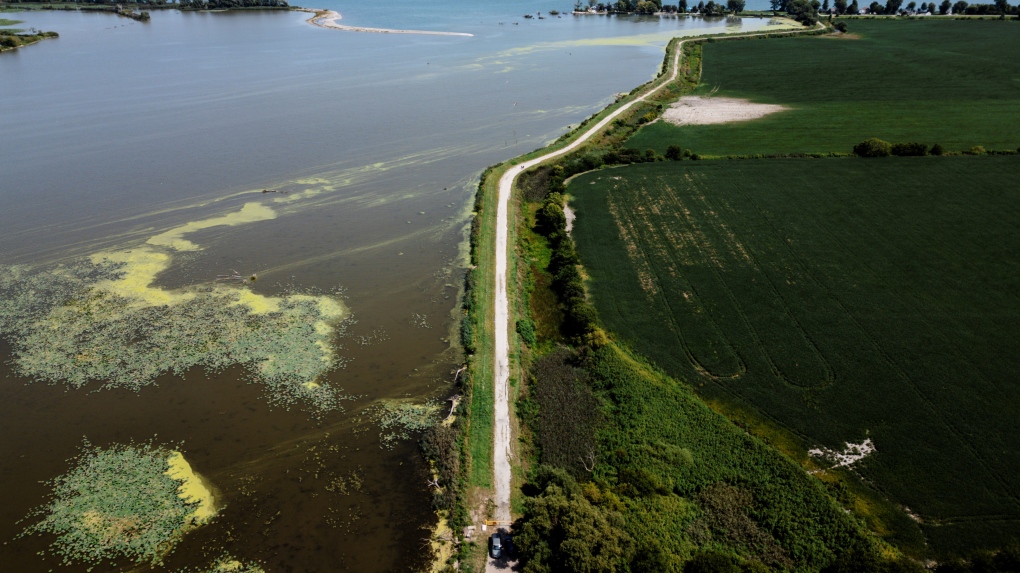Aquatic invasive species found for first time in Canada at Hillman Marsh
 The aquatic invasive plant, hydrilla. (Source: ERCA)
The aquatic invasive plant, hydrilla. (Source: ERCA)
The aquatic invasive plant, hydrilla, has been detected for the first time in Canada at a marsh in Leamington.
It was located in the West Cell at Hillman Marsh Conservation Area.
The Essex Region Conservation Authority (ERCA) is working closely with the Ministry of Natural Resources, the Invasive Species Centre, the Ontario Federation of Anglers and Hunters and many other partners to evaluate the extent of the infestation, contain the spread, and develop plans to control this invasive species. To date, surveys have shown the infestation to be limited to the contained wetland area of the West Cell of Hillman Marsh that is not directly connected to Lake Erie.
Hydrilla (Hydrilla verticillata) can grow up to 2.5 centimetres per day and to lengths of 7.5 meters. This rapid growing invasive species can choke out native species and clog water intake pipes, boat motors and impede other recreational activities like swimming and paddling.
Hydrilla is a prohibited invasive species under Ontario’s Invasive Species Act 2015.
In a pro-active effort to contain the spread of this invasive plant, ERCA will be immediately closing the West Cell of Hillman Marsh, including the trail and boardwalk, to boating, walking and hunting. Hydrilla is easily spread when boat propellers, kayaks, canoes, trailers, fishing and hunting gear, pets or people inadvertently carry attached plant fragments to new areas.
ERCA is asking the public for assistance in refraining from accessing this area. A drone image shows the Hillman Marsh and the dyke that protects the farmland to the south. (Image coutesy: Ian Duckworth)
A drone image shows the Hillman Marsh and the dyke that protects the farmland to the south. (Image coutesy: Ian Duckworth)
“Ontario recognizes the importance of the prevention, early detection and management of invasive species that pose a threat to Ontario’s native species and ecosystems. If left unchecked, hydrilla – an aggressive aquatic plant – has the potential to severely impact navigation, recreation, and aquatic life,” said Graydon Smith, Minister of Natural Resources. “That’s why we’re working diligently with our partners to develop plans for its control.”
ERCA’s director of conservation services Kevin Money said the detection of this highly aggressive water plant is alarming.
“Most concerning is its ability to significantly disrupt, alter and outcompete the natural ecosystem. We take its detection within our wetland with the utmost seriousness and are proactively taking all steps we can to contain it, including, unfortunately, halting recreational activities within the cell and its surrounding area.”
CTVNews.ca Top Stories

BREAKING Liberals table GST holiday legislation, putting $250 rebate on backburner
Prime Minister Justin Trudeau's promised holiday consumer relief package has been split in half. After NDP Leader Jagmeet Singh said his party was only ready to help pass the GST/HST holiday portion of the affordability announcement, Deputy Prime Minister and Finance Minister Chrystia Freeland tabled legislation Wednesday that only seeks to enact that measure.
Missing hiker found alive after 50 days in northern B.C. wilderness
A missing hiker who spent 50 days alone in the frozen wilderness of northern British Columbia has been found alive.
Boeing plane makes emergency landing at Montreal's Mirabel airport after landing gear malfunction
No injuries were reported after a Boeing 737 was forced to divert to Mirabel airport after the aircraft experienced a technical issue with the landing gear.
Montreal billionaire Robert Miller could have as many as 100 victims, lawyer says
A Quebec judge is hearing arguments this week in a class-action lawsuit application against Montreal billionaire Robert Miller over allegations he paid minors for sex.
Northern lights may be visible in some U.S. states and Canadian provinces this week
The northern lights could be visible for residents in northern and upper Midwest states in the U.S. as early as Thursday, including some Canadian provinces.
Two Canadians arrested for failed murder plot in California
Two men who travelled from Canada to Monterey County have been arrested and accused of attempted murder after a triple-stabbing Sunday.
Ontario to match GST holiday by removing provincial sales tax on some items
Ontario says it will match the federal government’s two-month GST holiday by removing provincial sales tax (PST) from items that are not currently covered by existing provincial rebates.
'They alone are responsible': No deal yet in Canada Post strike
The Canada Post strike is expected to continue as parties remain 'too far apart on critical issues' to reach a deal, according to Labour Minister Steven MacKinnon.
Hyundai recalling hundreds of thousands of cars and SUVs in Canada, U.S.
Hyundai is recalling hundreds of thousands of SUVs and small cars in the U.S. and Canada because the rearview camera image may not show up on the screens.






























